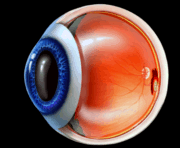|
Macular
Degeneration Diagnosis and Treatment
Macular
degeneration is a leading cause of impaired vision in the
elderly population. It is caused by the degeneration of the
macula, the central portion of the retina. Although macular
degeneration causes distortion of central and color vision,
side vision is not affected.
(place
mouse cursor over the "mountain meadow" diagram)
Macular
degeneration is a natural result of the aging process. With
time, the retinal tissues break down and become thin. This
deterioration causes a loss of function of the macula. Occasionally,
macular degeneration is caused by injury, infection, or inflammation.
The disease may also be hereditary.
The most
notable symptom of macular degeneration is blurry or distorted
central vision. Difficulty in reading, doing close work, or
driving may also be noticed. Distortion of the center of a
scene, a dark or empty area in the center of vision, or the
distortion of lines while reading are common symptoms as well.
Macular
degeneration may also cause a dimming of color vision. Fortunately,
the disease does not cause total blindness, as side vision
is not affected. Macular degeneration only affects central
and color vision. However, if macular degeneration occurs
in only one eye, the symptoms of the disease may not be noticed,
as the "good" eye compensates for the "bad" eye.

Unfortunately,
there is no cure for macular degeneration. However, laser
treatment may be used to slow the progression of the disease
in certain cases. Laser treatment can also be effective in
sealing leaky blood vessels and destroying abnormal vessels
so that hemorrhaging and scarring will not further decrease
central vision.
|



